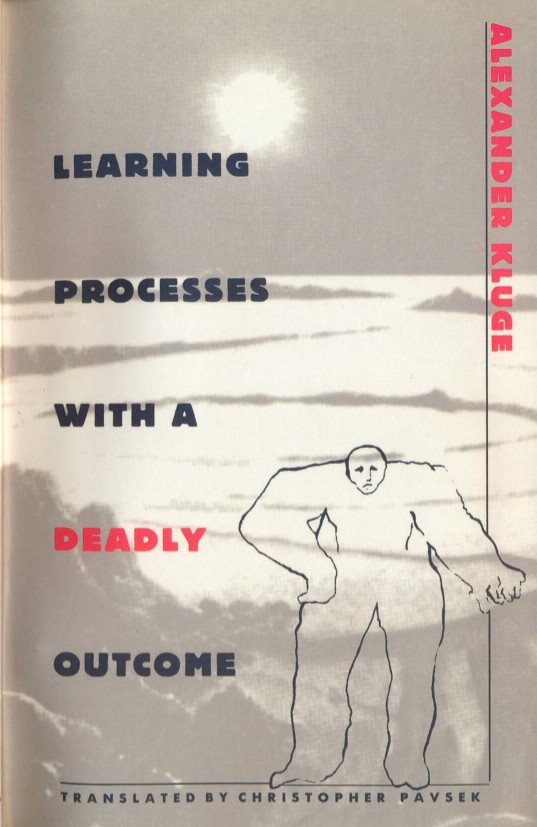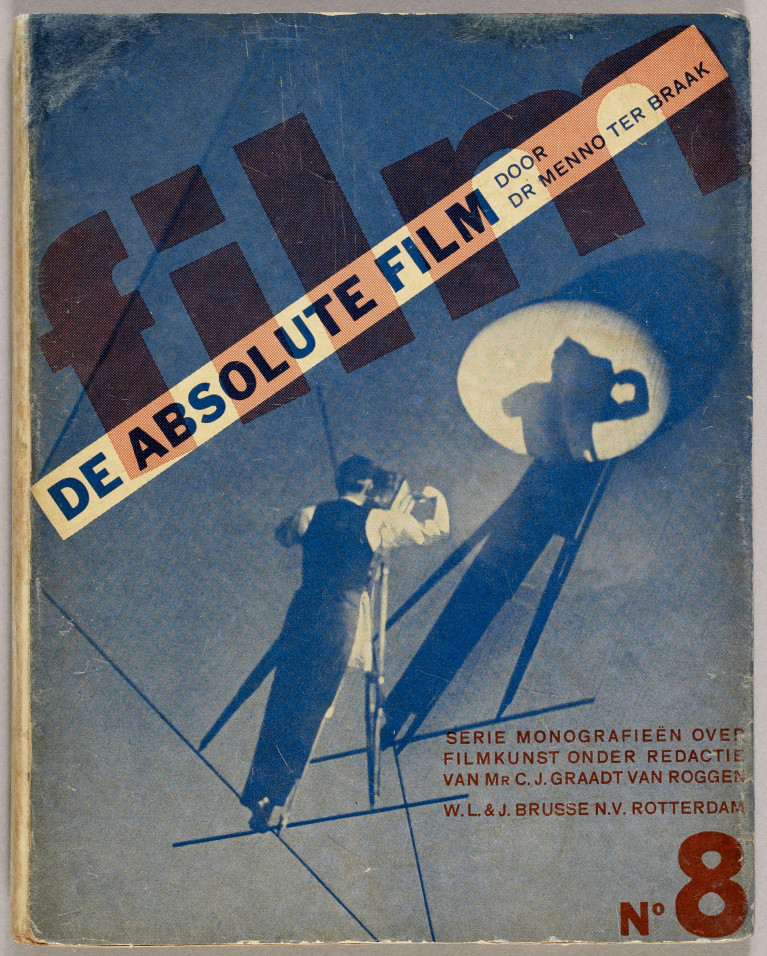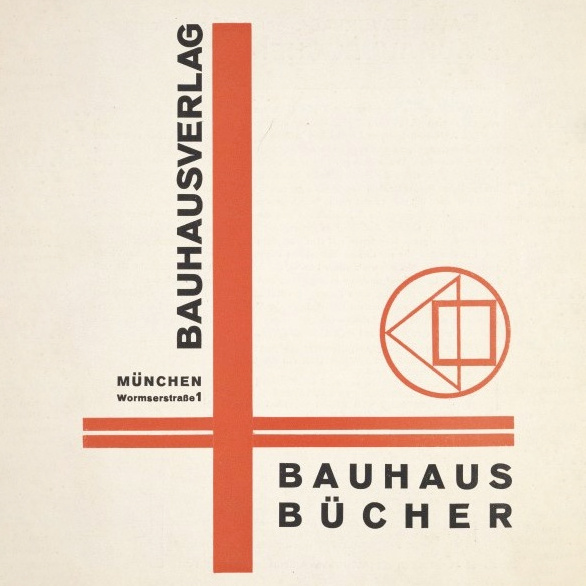Alexander Kluge: Learning Processes with a Deadly Outcome (1973–)
Filed under fiction | Tags: · capitalism, montage, science fiction, utopia

“Written in a quasi-documentary style, this fascinating hybrid work combines science fiction with modernist forms of montage and reportage to describe a future in which Earth has been almost totally destroyed following the catastrophic Black War. The planet’s remaining inhabitants have been driven underground or into space where the struggle to establish a new society rages on.
Whether describing the scene in China where the devastated landscape is reconstructed according to old paintings, or in the galactic realm of the Starway where giant, turf-battling, corporate colonizing forces exploit the universe’s resources, Kluge tells his tale by inventing various forms of “evidence” that satirize the discourses of administrative bureaucracy, the law, military security, and the media. He gives us some of his most bizarre and hilarious characters in this peculiar world in which the remains of the past are mixed with the most advanced elements of the future. The cast includes highly specialized women workers who have adapted to the massive gravitational field of their heavy-metal planets, a commander with lethal foot-fungus, and ex-Nazi space pioneers who, in their lonely exile from the conflagrations on earth, spend their time carving enormous facsimiles of operatic sheet music in the forests of uninhabited planets.
With parody, and humor, Kluge shows how the survivors of Armageddon attempt to learn the art of civilization, and, despite the disaster they have suffered, how they set out to reproduce at new sites a caricature of a classic and fascistic feudal capitalism.” (from the back cover)
First published as Lernprozesse mit tödlichem Ausgang, Suhrkamp, Frankfurt am Main, 1973.
Translated, with an Introduction and Afterword by Christopher Pavsek
Publisher Duke University Press, 1996
ISBN 0822317443, 9780822317449
xiv+112 pages
via Charles
PDF (21 MB, no OCR)
More from Kluge.
Series of Monographs on Cinema, 10 vols. (1931–33) [NL]
Filed under book | Tags: · abstract cinema, avant-garde, cinema, experimental film, film, film history, film sound, film theory, graphic design, montage, silent cinema


This set of monographs on early twentieth-century film is as important for the discourses on cinema, as it is for the graphic design.
Each volume has a cover created by the Dutch “typotekt” Piet Zwart, who had multiple careers as an interior designer, industrial design, commercial typographer, photographer, critic and lecturer. At the close of the twentieth century, Zwart was named ‘Designer of the Century’ by the Association of Dutch Designers.
Originally planned in twelve volumes, the last two in the series were not published: De techniek van de kunstfilm by M.T.H. Franken and Joris Ivens and Filmreclame by Piet Zwart.
Film: die serie monografieën over filmkunst
Series edited by C.J. Graadt van Roggen
Cover design Piet Zwart
Publisher W.L. & J. Brusse’s Uitgeversmaatschappij, Rotterdam, 1931-33
via Bibliothèque Kandinsky
Wikipedia (NL)
1 Het linnen venster, by C.J. Graadt van Roggen (1931, 72 pp, 71 MB)
2 Dertig jaar film [Thirty Years of Film], by L.J. Jordan (1932, 79 pp, 73 MB)
3 Nederlandsche filmkunst, by Henrik Scholte (1933, 64 pp, 63 MB)
4 Russische filmkunst, by Th. B.F. Hoyer (1932, 84 pp, 85 MB)
5 Duitsche filmkunst [German Cinema], by Simon Koster (1931, 75 pp, 71 MB)
6 Fransche filmkunst, by Elisabeth de Roos (1931, 59 pp, 61 MB)
7 Amerikaansche filmkunst, by Jo Otten (1931, 70 pp, 71 MB)
8 De absolute film, by Menno ter Braak (1931, 50 pp, 50 MB), HTML (at DBNL)
9 De komische film, by Constant van Wessem (1931, 56 pp, 49 MB)
10 De geluidsfilm [Sound Film], by Lou Lichtveld (1933, 79 pp, 76 MB), HTML (at DBNL)
Walter Gropius, L. Moholy-Nagy (eds.): Bauhaus Books, 10 vols. (1925–1930) [German]
Filed under book | Tags: · architecture, art, art education, bauhaus, dance, design, drawing, education, film, montage, painting, photography, sculpture, theatre

1. Walter Gropius, Internationale Architektur, 1925, 111 pp.
2. Paul Klee, Pädagogisches Skizzenbuch, 1925, 50 pp.
4. Die Bühne am Bauhaus, 1925, 84 pp.
7. Walter Gropius (ed.), Neue Arbeiten der Bauhauswerkstäffen, 1925, 115 pp.
8. L. Moholy-Nagy, Malerei, Fotografie, Film, 1925/27, 140 pp.
9. Kandinsky, Punkt und Linie zu Fläche: Beitrag zur Analyse der malerischen Elemente, 1926, 190 pp.
10. J.J.P. Oud, Holländische Architektur, 1929, 107 pp.
11. Kasimir Malewitsch, Die gegenstandslose Welt, 1927, 104 pp.
12. Walter Gropius, Bauhausbauten Dessau, 1930, 221 pp.
14. László Moholy-Nagy, Von Material zur Architektur, 1929, 241 pp.
Publisher Albert Langen, Munich, 1925-1930
via Bibliothèque Kandinsky
Download all 10 volumes through Monoskop wiki
Comment (0)
